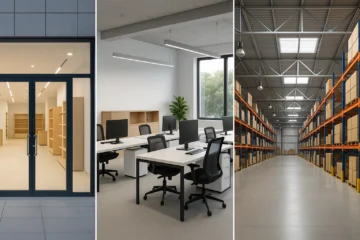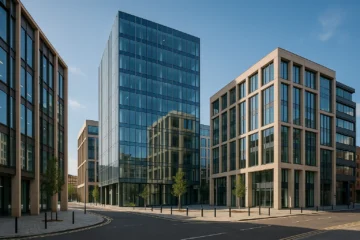1. Introduction
The UK commercial real estate market is dynamic, diverse, and a vital foundation for businesses across all industries. Commercial leasing, as a key component of this market, provides businesses with the flexibility to occupy prime locations without the financial burden of property ownership. Whether you’re a small startup or an established company looking to expand, understanding the fundamentals of commercial leasing can significantly impact your business’s long-term success.
This article serves as a comprehensive introduction to commercial leasing in the UK, covering lease types, essential terms, legal considerations, and practical tips to help you make informed decisions.
2. Understanding Commercial Leasing
Commercial leasing involves renting a property for business purposes. Unlike residential leases, which focus on personal habitation, commercial leases are tailored to support operational and logistical needs.
Key Features of Commercial Leasing:
- Tailored agreements for business activities.
- Wide range of property types: office spaces, retail units, industrial warehouses, etc.
- Flexible terms to suit varying business sizes and industries.
3. Types of Commercial Leases in the UK
The UK offers a variety of lease options, each suited to different business requirements:
- Full Repairing and Insuring Lease (FRI):
- Tenant covers maintenance, repairs, and insurance costs.
- Common for long-term leases in high-value properties.
- Internal Repairing Lease (IRI):
- Tenant maintains only the interior; landlord manages external upkeep.
- Suitable for smaller businesses or shared spaces.
- Short-Term vs. Long-Term Leases:
- Short-term: Flexible for startups or temporary operations.
- Long-term: Stability for established businesses but requires commitment.
- License to Occupy:
- For short-term or shared use, offering high flexibility.
- Often used for coworking spaces or temporary retail setups.
4. Essential Terms in a Commercial Lease
Understanding key terms can help you navigate lease agreements effectively:
- Lease Duration: Common periods range from 3 to 25 years, with break clauses offering flexibility.
- Rent Structure: Fixed rent, turnover-based rent, or hybrid models.
- Break Clauses: Allow tenants or landlords to terminate the lease early under certain conditions.
- Renewal Terms: Security of tenure under the Landlord and Tenant Act 1954 ensures renewal rights for eligible tenants.
- Service Charges: Cover shared facilities and building maintenance.
5. Legal and Regulatory Framework
The UK’s legal framework governs landlord-tenant relationships, ensuring fair practices:
- Landlord and Tenant Act 1954: Grants tenants rights to lease renewals unless excluded in the contract.
- Planning Permissions: Ensure the property’s intended use aligns with local regulations.
- Dilapidations: End-of-lease obligations for restoring the property to its original condition.
6. Key Considerations Before Signing a Lease
Careful evaluation can prevent costly mistakes:
- Location: Proximity to customers, suppliers, and transport hubs.
- Affordability: Budget for rent, service charges, and business rates.
- Space Requirements: Ensure the property supports current and future needs.
- Flexibility: Negotiate terms to allow for business growth or operational changes.
7. Benefits of Commercial Leasing in the UK
- Flexibility: Adjust to changing business needs without ownership commitments.
- Cost-Effectiveness: Avoid the high upfront costs of purchasing property.
- Access to Prime Locations: Occupy prestigious areas otherwise inaccessible through ownership.
8. Common Challenges in Commercial Leasing
- Hidden Costs: Understand dilapidation liabilities and service charges.
- Lease Negotiations: Ensure terms align with business interests.
- Limited Flexibility: Long-term leases can restrict adaptability.
9. Tips for First-Time Commercial Lessees
- Engage a Commercial Property Agent: They can help identify suitable properties and negotiate favorable terms.
- Conduct Inspections: Check the property’s condition and compliance with regulations.
- Understand the Lease: Review all clauses, especially regarding break clauses and renewal rights.
- Budget for Extras: Factor in service charges, legal fees, and other costs.
10. Conclusion
Understanding the fundamentals of commercial leasing is crucial for making strategic decisions that benefit your business. By familiarizing yourself with lease types, legal requirements, and key considerations, you can secure a property that aligns with your goals and supports your success
FAQ Section
Q1: What is the most common type of commercial lease in the UK?
A: The Full Repairing and Insuring Lease (FRI) is the most common, requiring tenants to cover maintenance and insurance costs.
Q2: Can I negotiate a shorter lease term?
A: Yes, many landlords offer flexible terms, particularly for startups or small businesses.
Q3: What are dilapidations in a lease?
A: Dilapidations are the tenant’s obligations to restore the property to its original condition at the end of the lease.
Q4: Do I need a lawyer to review my lease?
A: Yes, a legal advisor can help you understand the terms, negotiate better conditions, and avoid potential pitfalls.


